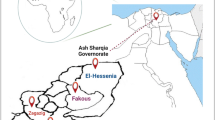Abstract
Giardia intestinalis is a protozoan parasite and a human pathogen. It is a leading cause of human diarrheal disease and a significant cause of morbidity worldwide. At the molecular level, G. intestinalis is a species complex, consisting of genetic assemblages (A to G) and sub-assemblage strains. The genotypes that cause human disease have been characterised to assemblages A and B, and include strains AI, AII, BIII and BIV. PCR amplification of diagnostic loci is used to genotype samples and is required to understand different transmission cycles within communities. A multi-locus approach is required for validation of Giardia genotyping and molecular diagnostic techniques that are efficient across numerous loci have not been established. This study evaluated several published protocols for the 18S small subunit ribosomal RNA (18S rRNA) and glutamate dehydrogenase genes (gdh) genes. Assays were compared using spiked faecal samples and by measuring the concentration of DNA generated following DNA extraction and PCR amplification. An optimal molecular method for G. intestinalis identification was established from direct DNA extraction of faecal material and GC-rich PCR chemistry. The protocol was applied to 50 clinical samples and produced PCR success rates of 90% and 94% at the 18S rRNA and gdh loci. Cyst concentration prior to DNA extraction was not necessary, and the optimal protocol was highly sensitive and an efficient method for testing clinical samples.

Similar content being viewed by others
References
Caccio SM, Ryan U (2008) Molecular epidemiology of giardiasis. Mol Biochem Parasitol 160:75–80
Caccio SM, De Giacomo M, Aulicino FA, Pozio E (2003) Giardia cysts in wastewater treatment plants in Italy. Appl Environ Microbiol 69:3393–3398
Caccio SM, Thompson RCA, McLauchlin J, Smith HV (2005) Unravelling Cryptosporidium and Giardia epidemiology. Trends Parasitol 21:430–437
Ferrari BC, Vesey G, Weir C, Williams KL, Veal DA (1999) Comparison of Cryptosporidium-specific and Giardia-specific monoclonal antibodies for monitoring water samples. Water Res 33:1611–1617
Ferrari BC, Power ML, Bergquist PL (2007) Closed-tube DNA extraction using a thermostable proteinase is highly sensitive, capable of single parasite detection. Biotechnol Lett 29:1831–1837
Hopkins RM, Meloni BP, Groth DM, Wetherall JD, Reynoldson JA, Thompson RCA (1997) Ribosomal RNA sequencing reveals differences between the genotypes of Giardia isolates recovered from humans and dogs living in the same locality. J Parasitol 83:44–51
Monis PT, Andrews RH, Mayrhofer G, Ey PL (1999) Molecular systematics of the parasitic protozoan Giardia intestinalis. Mol Biol Evol 16:1135–1144
Nantavisai K, Mungthin M, Tan-ariya P, Rangsin R, Naaglor T, Leelayoova S (2007) Evaluation of the sensitivities of DNA extraction and PCR methods for detection of Giardia duodenalis in stool specimens. J Clin Microbiol 45:581–583
Pelayo L, Nunez FA, Rojas L, Furuseth Hansen E, Gjerde B, Wilke H, Mulder B, Robertson L (2008) Giardia infections in Cuban children: the genotypes circulating in a rural population. Ann Trop Med Parasitol 102:585–595
Power ML, Shanker SR, Sangster NC, Veal DA (2003) Evaluation of a combined immunomagnetic separation/flow cytometry technique for epidemiological investigations of Cryptosporidium in domestic and Australian native animals. Vet Parasitol 112:21–31
Read C, Walters J, Robertson ID, Thompson RCA (2002) Correlation between genotype of Giardia duodenalis and diarrhoea. Int J Parasitol 32:229–231
Read CM, Monis PT, Thompson RCA (2004) Discrimination of all genotypes of Giardia duodenalis at the glutamate dehydrogenase locus using PCR-RFLP. Infect Genet Evol 4:125–130
Roxstrom-Lindquist K, Palm D, Reiner D, Ringqvist E, Svard SG (2006) Giardia immunity—an update. Trends Parasitol 22:26–31
Savioli L, Smith H, Thompson A (2006) Giardia and Cryptosporidium join the ‘Neglected Diseases Initiative’. Trends Parasitol 22:203–208
Smith HV, Caccio SM, Tait A, McLauchlin J, Thompson RC (2006) Tools for investigating the environmental transmission of Cryptosporidium and Giardia infections in humans. Trends Parasitol 22:160–167
Sulaiman IM, Fayer R, Bern C, Gilman RH, Trout JM, Schantz PM, Das P, Lal AA, Xiao L (2003) Triosephosphate isomerase gene characterization and potential zoonotic transmission of Giardia duodenalis. Emerg Infect Dis 9:1444–1452
Traub RJ, Monis PT, Robertson ID (2005) Molecular epidemiology: a multidisciplinary approach to understanding parasitic zoonoses. Int J Parasitol 35:1295–1307
van der Giessen JWB, de Vries A, Roos M, Weilinga P, Kortbeek LM, Mank TG (2006) Genotyping of Giardia in Dutch patients and animals: a phylogenetic analysis of human and animal isolates. Int J Parasitol 36:849–858
Waldron LS, Ferrari BC, Gillings MR, Power ML (2009) Terminal restriction fragment length polymorphism for identification of Cryptosporidium species in human feces. Appl Environ Microbiol 75:108–112
Wilke H, Robertson LJ (2009) Preservation of Giardia cysts in stool samples for subsequent PCR analysis. J Microbiol Meth 78:292–296
Acknowledgments
This research was conducted with financial assistance from Macquarie University. We would like to thank Dr. Jacqui Uprcoft of the Queensland Institute of Medical Research for kindly providing trophozoites and also Douglass Hanly Moir Pathology, Symbion Health Laverty Pathology, Hunter Area Pathology Service, Westmead Hospital & John Hunter Hospital for their invaluable help in providing faecal samples.
Author information
Authors and Affiliations
Corresponding author
Rights and permissions
About this article
Cite this article
Asher, A.J., Waldron, L.S. & Power, M.L. Evaluation of a PCR protocol for sensitive detection of Giardia intestinalis in human faeces. Parasitol Res 110, 853–858 (2012). https://doi.org/10.1007/s00436-011-2565-3
Received:
Accepted:
Published:
Issue Date:
DOI: https://doi.org/10.1007/s00436-011-2565-3




